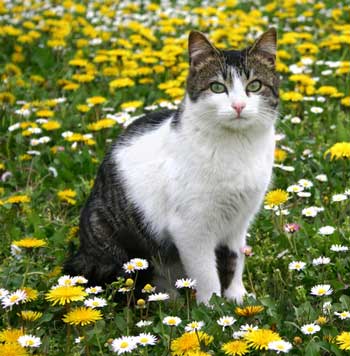Hypothermia and Heatstroke in Cats

Many people feel that cats are somehow immune to extreme cold or hot temperatures, but that is simply not the case. Cats can suffer from frostbite or hypothermia in cold weather and life-threatening heatstroke in hot weather.
Cold Weather Cat Dangers
"Cool cats" is just a saying and should never be a real life problem for your cat. When a cat is let outdoors or lives in a drafty, moist barn or shed in the northern winter, whole body chilling (hypothermia) and frostbite can sometimes occur.
Some Cats Are at Higher Risk Than Others
Cats are pretty well protected against the cold because of their excellent coat, but some breeds are better endowed with protection than others. The Siberian forest and Norwegian forest cats evolved in the far north of Europe, and these large cats carry an outstanding water-repellent fur coat, as do the Maine Coon cats that are from the northeastern USA. These cats were historically left outside and adapted to dealing with cold weather.
The Devon and Cornish rex, sphynx cat, and other lightly coated cat breeds are not so lucky. A typical domestic longhair or shorthair cat is pretty hardy, but in reality, is still subject to suffering in sub-zero cold, though hypothermia is less commonly seen at the veterinary clinic than hyperthermia (heatstroke).
Preventing Hypothermia in Cats
Prevention of hypothermia and frostbite in cats involves keeping cats indoors or in a heated building during severely cold weather. If you look after feral or barn cats, provide a well-bedded shelter that will keep out the wind, snow, and ice. Placing a few covered, insulated cat beds (just big enough to fit a cat) around a barn out of the drafts can give your cat a choice of secure, dry hiding spots to keep warm.
Kittens and senior cats are most susceptible to the cold, and in a barn or other structure, hanging a light bulb a few feet above kittens inside a fireproof enclosure can warm up the air inside in order to provide reasonably comfortable temperatures. This is a method that farmers use for warming newborn piglets and chicks. Special red heat (infrared) bulbs for livestock can be purchased for this purpose. Ideally, Mom and her babies should be moved indoors if serious fall, winter, or spring cold snaps occur.
Treating Cold Exposure in Cats
If you suspect a cat is chilled, take him into a heated environment for a few hours at the minimum. Watch the kitty carefully to ensure she is alert, eating, and active. If you notice any discolored areas of skin, especially on the ears, toes, or tail, it might be the beginning of frostbite, and you should get to the veterinarian right away.
Hot Weather and Cat Safety
At the other end of the spectrum, heatstroke in cats is an emergency seen more commonly at the veterinary hospital. Cats left inside vehicles on a warm summer day are the most common victims of overheating. A locked vehicle can easily reach 104° F within 15 minutes, especially if there is a black interior. Cats with heavy, dense coats such as Persian and Persian-type cats suffer most. Obese cats are also more prone to heat stroke because the extra layer of body fat tends to soak up the heat. Young kittens and senior cats likewise have a reduced ability to process the heat load.
A cat with chronic disease such as a heart condition is less able to cope with overheating, and so is a cat with respiratory problems or that has a naturally flat face.
Cats Can Develop Heatstroke Quickly
Cats can die quickly from heatstroke. Never leave a cat in your car for even a few minutes in summer because even partially opened windows may not allow for the heat to vent.
Using a hair dryer on hot setting close to the cat and being out in the very hot sun where little shade is available are other circumstances that can precipitate overheating in cats.
What to Do if You Suspect Your Cat Is Overheated
If you suspect heatstroke and the cat is panting with mouth open, is drooling, has dilated pupils, is weak or has collapsed, or is vomiting or crying, take a temperature and begin cooling the cat.
In extreme cases, seizures and unconsciousness may develop. Hopefully, you have a first aid kit for cats handy.
Take your cat to the local veterinary hospital immediately—sit him on or wrap him in a towel dampened with cool water for travel if the car is very hot (no car air conditioning). NOTE: A warm nose is not an accurate indicator of the cat's body temperature; you must take a rectal temperature.
The normal temperature for a cat is usually 100.5° to 102.5° F. A temperature of over 104° F is serious, while above that, the 106°-107° F range indicates dangerous overheating. At this level, organ damage may occur, and if not corrected, sustained high temperatures can lead to death. Use a digital thermometer with lubrication in the anus to check a temperature—leave it in until it beeps. Petroleum jelly or sterile lubricating jelly will serve to lubricate the instrument and should be in your first aid kit.
Call the hospital to obtain advice and arrange for the cat to be seen immediately there. Apply cool water to the cat—the wetting of the fur will rapidly cool the cat. Use a garden hose on low flow, place the kitty in a sink or tub, or just pour water on the cat. Make sure the coat is wetted right down to the skin. Offer water to drink if the cat is alert. Do not use ice water—that will over-correct the problem and lead to chilling. Monitor body temperature every 15 minutes, and stop cooling procedures and towel dry the cat when a high normal temperature is reached. If there has been serious overheating, your veterinarian may need to treat for shock.
The too hot or too cold kitty is a serious emergency. Don't delay treatment or veterinary follow-up.
You May Also Like These Articles:
Hypertrophic Cardiomyopathy: HCM in Cats
Saddle Thrombus: Aortic Blood Clots in Cats
Alternative and Holistic Veterinary Medicine for Cats
How to Avoid Costly Veterinary Bills for Your Cat
Moving with Cats: Easing a Move for You and Your Cat
Notice: Ask-a-Vet is an affiliated service for those who wish to speak with a veterinary professional about their pet's specific condition. Initially, a bot will ask questions to determine the general nature of your concern. Then, you will be transferred to a human. There is a charge for the service if you choose to connect to a veterinarian. Ask-a-Vet is not manned by the staff or owners of CatHealth.com, and the advice given should not delay or replace a visit to your veterinarian.






